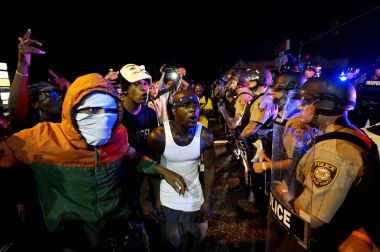Ferguson protest: Man critically injured in police shooting

A man was gravely wounded in a gun battle with police as street protests turned violent in Ferguson, Missouri, on Sunday night, capping a day of peaceful rallies to mark the fatal shooting of an unarmed black teenager by a white officer one year ago.
Several volleys of gunshots rang out as police in riot gear tried to disperse demonstrators blocking traffic and smashing storefront windows along a street that was a flashpoint of last year's unrest in the St. Louis suburb after Michael Brown, 18, was slain.
Police later said Sunday night's gunfire began with two groups of agitators apparently shooting at each other before one gunman darted across a parking lot and was confronted by four officers who pulled up in an unmarked vehicle.
The suspect then opened fire on the police vehicle and was badly wounded in the ensuing foot chase and exchange of gunshots with the four detectives, police said.
St. Louis County Police Chief Jon Belmar said the unidentified man, believed to be in his mid-20s, was hospitalized in critical and unstable condition.
Speaking to reporters at a predawn news conference on Monday, Belmar estimated that more than 40 rounds had been unleashed in what he called "a remarkable amount of gunfire."
"These were criminals; they weren't protesters," he said of the shooters. "There is a small group of people out there that are intent on making sure that we don't have peace that prevails."
At least three officers were injured in the melee, one struck in the face with a brick hurled from the crowd and two others pepper-sprayed by protesters, Belmar said.
A member of the local news media was also robbed and assaulted in a nearby parking lot amid Sunday night's turmoil, during which police reported making five arrests.
Separately, two teenage males were shot early on Monday in a drive-by attack near a sidewalk shrine erected in Brown's memory beside the spot where he was killed, but their wounds were not considered life-threatening, police said.
Anniversary commemorations had begun hours earlier with a peaceful march through the St. Louis suburb.
The scene changed dramatically after dark. Dozens of protesters converged on West Florissant Avenue, which bore the brunt of last summer's rioting, and chanted: "Shut it down" in the midst of a severe thunderstorm.
A phalanx of helmeted police wearing body armour and carrying shields moved in. Protesters briefly fell away before regrouping to confront the line of officers, who ordered them to disperse.
The protesters, locking arms and edging closer to the police cordon, began throwing water bottles and shouting: "We are ready for war!" Both sides held their ground while clergy members and activists appealed for calm.
GUNFIRE AND BLOODSHED
Bursts of gunfire shattered the face-off, sending police crouching behind their patrol cars and demonstrators scurrying for cover. Helicopters whirred overhead as additional police armed with assault rifles swarmed the area, some roaring down the street in armoured vehicles in the direction of the gunfire.
Merchants, some armed, stood guard outside their businesses early Monday after the disturbances, which unfolded around the corner from where Brown was gunned down on August 9, 2014, by officer Darren Wilson.
The death of Brown and a grand jury decision to spare Wilson from criminal charges for shooting him sparked a prolonged wave of demonstrations in Ferguson last year that boiled over into rioting and arson at times and spawned sympathy rallies across the country.
It also led to greater scrutiny of racial bias within the U.S. criminal justice system, giving rise to the "Black Lives Matter" movement that gained momentum from other high-profile slayings of unarmed minorities by white police in cities such as New York, Baltimore, Los Angeles and Cincinnati.
The unrest that erupted Sunday night was in marked contrast to a day of mostly subdued, peaceful commemorations in Ferguson and elsewhere.
White doves were released after 4-1/2 minutes of silence to represent the roughly 4-1/2 hours that Brown's body lay in the middle of the street after he was shot. A crowd of about 1,000 then embarked on a silent march through Ferguson to honour Brown and others killed in confrontations with police.
Another name was added to that list on Friday when unarmed Christian Taylor, a 19-year-old black college student, was shot dead by a white police officer investigating a burglary at a car dealership in Arlington, Texas.
A federal review of Brown's slaying found that officer Wilson had acted lawfully, but it also determined that Ferguson's predominantly white police department had for years violated the rights of the city's black population.
The Justice Department report concluded police were singling out black people for arrests and ticketing, in part to raise revenue for the city. It also found a pattern of excessive police force against unarmed black citizens. The city's police chief, city manager and municipal court judge all subsequently left their jobs.











